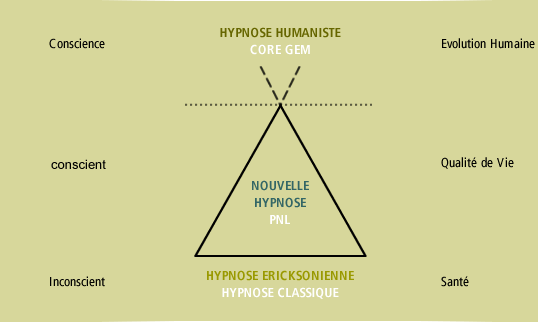Four Main Types of Hypnosis
Classical Hypnosis
Today we see it primarily onstage as a form of entertainment ; yet, this was the very first form of hypnosis. The hypnotist is very dominant and authoritative, making direct suggestions like “Sleep now !”.
This type of direct approach, while impressive, only works on small portion of the population, estimated to be about 10%. It still has some medical uses.
Ericksonian Hypnosis
Less direct and more permissive than classical hypnosis, Ericksonian hypnosis evolved into a fine art which incorporated the use of indirect suggestion and nonspecific language to generate change from the unconscious mind. This more effective approach to hypnosis works on everyone, and while still somewhat paternalistic and directive, it was widely modeled and appreciated by many well-known therapists in the 20th century such as those in the school of Palo Alto, Jay Haley, Daniel L. Araoz, David Calof, O’Hanlon and others.
New Hypnosis
Hypnosis finally evolved to be a contemporary tool for self development, not just a means of repairing psychological or psychiatric problems. Erickson’s methods were maintained yet refined to conform to modern sensibilities by many of the therapists mentioned above. The techniques of neurolinguistic programming only enhanced its effectiveness.
Humanist Hypnosis
The final evolution for hypnosis, which, ironically enough, makes a full circle and brings it back to its ancient origins as a holistic treatment on the physical, mental and spiritual levels. At the same time, it incorporates the latest knowledge of the brain, mind and quantum physics. Mystics have been telling us for thousands of years that “everything is connected”, and now physicists are saying the same thing.
Developed by Oliver Lockert in France (although similar approaches are appearing elsewhere), Humanist Hypnosis offers a way to treat psychological and physical problems through a state of expanded awareness and sense of connectedness — somewhat similar to certain types of meditation. With its inductions “in expansion” which are technically the opposite of all other forms of hypnosis, Humanist Hypnosis allows the person to become more conscious, not less, and seeks to reunite all the parts of the person in the interest of healing and greater evolution for the person as well as for humanity. To listen to an example of a Humanist induction in English, click here: https://soundcloud.com/mp3-hypnose-gratuit/humanist-hypnosis-in-english


Recent Comments